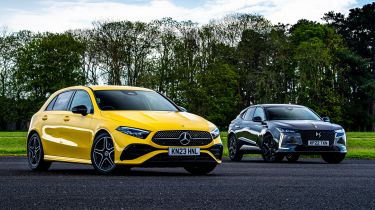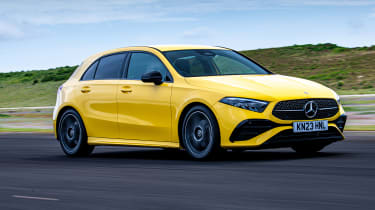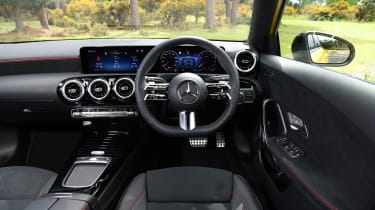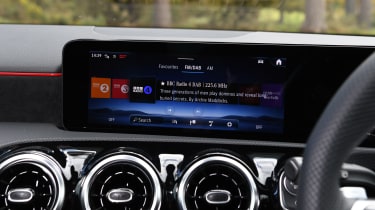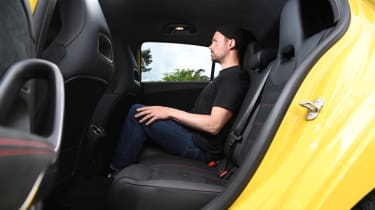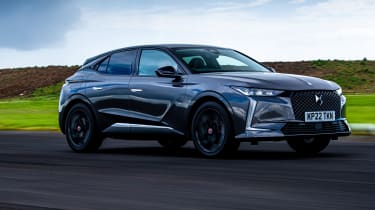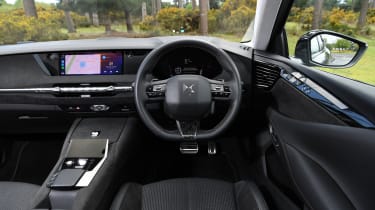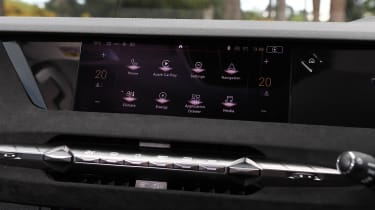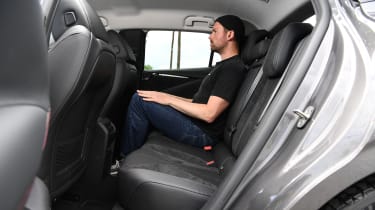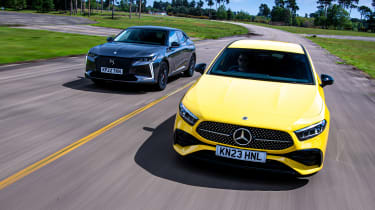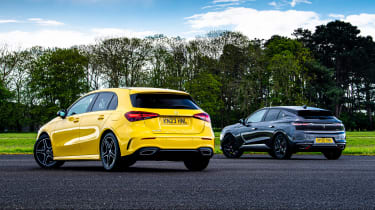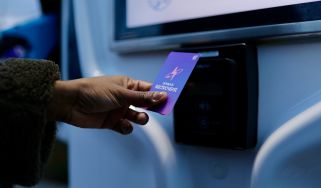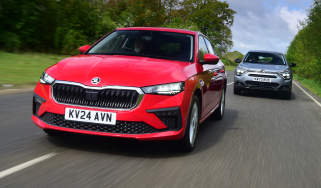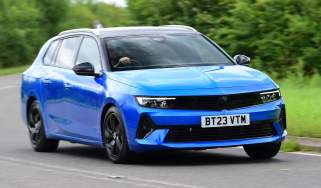Mercedes A-Class vs DS 4: 2023 twin test review
The Mercedes A-Class is the definition of a premium hatchback – can the DS 4 deliver a fresh alternative?
Choosing a premium hatchback used to be easy. If you wanted something posh and small, you’d probably go for a German model, such as the Mercedes A-Class.
The smallest car in the firm’s line-up is a solid choice because it looks smart, drives well and feels glitzy. Now there’s a revised model, which gains subtle styling changes and updates to the powertrains and in-car tech. Here we’re trying the new A 200 mild-hybrid petrol.
But is it still the default choice? The DS 4 might have something to say about that. The French upstart has already proved itself by beating the Audi A3 in plug-in hybrid form, but here we’re testing it as a pure petrol. Does it have the talent to overcome the Mercedes too?
|
Mercedes A 200 AMG Line Executive |
DS 4 PureTech 130 Performance Line + | |
|
Price: |
£35,555 |
£33,355 |
|
Powertrain: |
1.3-litre 4cyl turbo MHEV, 161bhp, seven-speed auto |
1.2-litre 3cyl turbo, 129bhp, eight-speed auto |
|
0-62mph: |
8.2 seconds |
10.4 seconds |
|
WLTP economy: |
44.8mpg / 9.9mpl |
41.4mpg / 9.1mpl |
|
CO2: |
135 g/km |
138 g/km |
|
Annual VED: |
£170 |
£180 |
Mercedes A-Class
We’re testing the new Mercedes A-Class in its second most attainable trim: AMG Line Executive. The only optional extra fitted to this test car is the Sun Yellow paint, which adds £625, taking the on-the-road price to £36,155.
Tech highlights
While some mid-life facelifts tend to be purely cosmetic, improved powertrains are the key focus of the revised A-Class line-up. The saloon-only A 250 e plug-in hybrid gains 6bhp from the electric motor (now 107bhp, for 215bhp in total), faster 11kW charging, and an electric range of up to 50 miles.
In the A 180 and the A 200 we’re driving here, 48-volt mild-hybrid tech is introduced to the existing 1.3-litre turbocharged petrol. It reduces the load on the engine by adding up to 13bhp of electrical boost, and this, alongside a more proactive start-stop system, helps to improve fuel consumption. Total power for the A 180 stands at 134bhp, while the A 200 gets 161bhp; the latter is backed up by a generous 270Nm of torque. Power is sent to the front wheels via a seven-speed dual-clutch automatic gearbox.
The mechanical set-up elsewhere is much the same. That means the A-Class has multilink rear suspension, which is more advanced, but harder to package than the DS 4’s torsion-bar arrangement.
Safety: The A-Class was tested by Euro NCAP in 2018, and it scored a five-star rating. In that year, its vulnerable-road-users category score of 92 per cent was the best of any car tested, and its child- occupant-protection rating of 91 per cent was the equal highest mark. Its adult occupant score of 96 per cent was beaten only by the Volvo XC40. Among the safety-assist systems that have been tweaked is the optional Parking Pack, which is now able to support parallel-parking manoeuvres.
On the road
The way the A-Class drives is largely unchanged, so it’s not without its flaws. However, mild-hybrid tech improves the powertrain.
Around town: Ride comfort has always erred towards the firmest end of this segment, and that shortage of compliance at low speed is still present in the updated A-Class. It’s not harsh, but potholes and broken asphalt tend to jiggle occupants around. In contrast to the ride, the new mild-hybrid powertrain works very smoothly, cutting the engine out and starting it up again quickly, while smoothing off some of the previous lumpiness in this engine-and-gearbox combination.
A & B-roads: The A-Class is at its best on smoother, faster roads, where the fidget disappears and that firm ride helps to resist body roll. It’s not a particularly fun car to drive, but the precise steering and neutral handling mean that it’s unlikely to throw up any nasty surprises.
With 161bhp, performance from the A 200 is fairly strong. The 0-62mph sprint takes 8.2 seconds, with a consistent power delivery throughout the rev range. The engine note does sound harsh when you make the most of its performance, though. The gearbox can be controlled by steering-wheel paddles, but it defaults back to auto quickly. If you want to take full control, then you need to dive into the touchscreen to select manual mode.
Motorway: Refinement is always an area where we’ve expected the A-Class to perform better, and the updated car hasn’t fixed this. At higher speeds, engine drone is drowned out by plenty of road noise. Wind noise is well suppressed, though, with just a little rustle around the A-pillars. There’s no faulting the A 200’s high-speed stability, either.
Ownership
Mercedes has made efforts to improve sustainability inside by using more recycled materials, including the seat foam and upholstery, where up to 100 per cent is reprocessed fabric. Build quality feels sturdy enough, but there are some hard, scratchy plastics to be found in the cabin – the lower door panels feel cheap – while the shiny, piano-black finishes used extensively in the cabin will likely be susceptible to scuffs.
Materials aside, the only significant change comes with improved touchscreen technology, which we’ll go into in greater detail in the infotainment section. That means the overall design remains the same, with a smart, slightly jazzy layout that has a sense of occasion.
The driving position has plenty of adjustment – especially for the steering wheel – but the latest rim design comes with fiddly touch-sensitive controls for adjusting various functions. At least the split-spoke design separates different groups of functions to each spar (cruise control on the lower left spoke, phone functions on the lower right, etc).
On the plus side, Mercedes has kept physical controls for the heating. The little rocker switches are intuitive and have a pleasing tactile feel.
The A-Class is covered by a three-year, unlimited- mileage warranty and three years of breakdown cover. The latter can be extended to a maximum of 30 years if you stick with main dealer servicing.
Storage: The A-Class cabin looks stylish, but also has plenty of space to store things. A sliding lid at the base of the dash hides a pair of cup-holders and a large space for a smartphone, while the central armrest is deep and features double doors that hinge from the edges, so it’s easy for either the driver or the front passenger to get inside.
Mercedes could have improved the door bins by trimming their insides, though; as it is, smaller items and plastic bottles can rattle around.
Practicality
In terms of passenger space, the Mercedes is about average for the class, but boot space lags behind.
Rear Space: Against the tape measure, the amount of head and kneeroom seem reasonably competitive for the segment. However, the seat base is set quite low, which means taller occupants will find the rear bench offers only limited under-thigh support. A high transmission tunnel and perched centre seat mean it isn’t very comfortable for three in the back.
Boot: At 355 litres, the A-Class offers below-average boot space. Versatility has been harmed in the revised A 200, because the mild-hybrid battery sits beneath the boot, taking up what was previously extra underfloor storage. A 40:20:40-split rear bench is a useful touch, and with all three parts folded down, the volume grows to 1,195 litres.
What to buy?
Which engine and trim we’d choose
- Engines: Of the two petrol models, the A 200 is the one to have; it offers more power with near-identical real-world economy. For roughly £1,000 more, the A 200 d promises 50Nm more torque and even better efficiency.
- Trims: Five trim levels are offered, with our AMG Line Executive model the second from the bottom of the line-up.
- Options: AMG Line Premium Plus and Launch Edition trims offer a £1,495 Driving Assistance Package, which adds extra safety kit. Beyond that, the only options are exterior colour choice.
- Our choice: The A 200 AMG Line Executive tested here is the sweet spot of the range.
DS 4
The car you see in these photos is a DS 4 E-Tense PHEV Performance Line+ that we’re running on our long-term test fleet. To get price and powertrain parity with the A-Class, the figures we use here are for the 1.2 PureTech petrol, which in Performance Line+ trim costs £33,355.
Tech highlights
While the A-Class has a platform that is only used by a small selection of Mercedes models, such as the B-Class and CLA, the DS 4 shares its EMP2 underpinnings with a wider pool of mainstream models. The wheelbase of 2,675mm is almost identical to that of the Peugeot 308 and Vauxhall Grandland, yet EMP2 is also used in DS’s larger models, the DS7 and DS9.
The DS 4’s engine is also familiar. The 1.2-litre three-cylinder PureTech petrol unit is used across a wide range of brands, but in a premium model such as this, its on-paper stats look a little on the light side. At 129bhp, it’s 32bhp down on the A 200, while its peak torque of 230Nm is also lower – although that figure at least arrives at a diesel-like 1,750rpm. At 1,352kg, the DS4 is the lighter of our two contenders, tipping the scales at 88kg less than the Mercedes.
An optional Active Scan suspension system features adaptive dampers that prepare for bumps using forward-facing cameras.
Safety: The DS 4 only received a four-star rating when it was tested by Euro NCAP in 2022. Its main potential for improvement, according to NCAP, was in the safety assist category, where it was noted that its autonomous emergency braking system wasn’t the most effective set-up when it came to reacting to other cars, earning a ‘marginal’ rating as a result.
On the road
While the Mercedes is set up to feel firm and sporty, the DS 4 takes the opposite approach. It’s all the better for taking a different angle in this class, but straight-line performance is a little lacking.
Around town: On roads where the Mercedes bounces and squirms, the DS filters out the same bumps as if they aren’t even there. The suspension hardware is well insulated from the cabin, too, so the knocks you do feel rarely interrupt the peaceful cabin. Low-speed driving is let down by a clunky automatic gearbox; the relationship between it, the brakes and the stop-start system makes bringing the car to a smooth halt almost impossible.
A & B-roads: On twistier roads, the DS 4’s soft suspension produces more body roll than the Mercedes’ set-up. However, the DS never feels wayward, instead moving enough to make swift, flowing progress easy. The steering is light and less precise than in the A-Class, but it’s well matched to the chassis response. Where the DS really lags behind is performance. A 10.4-second 0-62mph time is 2.2 seconds off the A-Class, so getting up to motorway speeds takes more forward planning. The three-cylinder petrol unit is more refined than the 1.3-litre four cylinder in the Mercedes, though; even under hard acceleration it makes less fuss. The eight-speed gearbox isn’t the most responsive, but drive in the easy-going nature that the suspension encourages, and it performs smoothly enough.
Motorway: There’s less noise in the DS 4 than you get from the A 200’s tyres, and the engine is quieter. The smooth ride is relaxing at speed, but the less precise steering means the DS 4 doesn’t quite feel as planted as the A-Class.
Ownership
Step from the cabin of the Mercedes and into the DS, and you won’t feel short changed. Build quality is on par with the German car’s, and while there are perhaps a few too many different textures used throughout – the lower steering wheel spoke features a panel of what looks like recycled carbon fibre, but was the only place where we found it – many feel of a higher quality than the materials used in the A-Class. Our Performance Line+ model had Alcantrara trim across the dash, while the range-topping variants get leather instead.
The driving position isn’t quite so easy to get along with as the A-Class’s, because the dashboard feels higher, so the view out isn’t quite as clear unless you jack the seat up into a slightly unnatural position. The views both over the shoulder and out of the small back window are poor, too.
While DS didn’t feature in our Driver Power ranking in 2022, an excellent fourth place overall for Peugeot, and Citroen’s mid-table finish in 13th means that we’d expect fairly strong results from the premium Stellantis brand. The 3008, whose underpinnings are derived from the same architecture as the DS 4, came 13th in the individual model rankings. Roughly 18 per cent of Peugeot and Citroen drivers have experienced some sort of fault during ownership, which is lower than the 27 per cent of Mercedes drivers surveyed, and beats Audi (19 per cent) and BMW (23 per cent), too.
Storage: Unlike the Mercedes, the DS gets carpeted door bins, which are integrated into the swoopy interior design. Unlike previous cars from the French side of the Stellantis group, the fuse box is no longer located in the glovebox, so the DS 4 offers plenty of space there, too. The storage in the front console is slightly roomier than in its rival, and a small hollow just ahead of the central armrest and storage cubby is ideal for holding the key while driving.
Practicality
A generous boot capacity makes the DS 4 the most practical car in its class.
Rear space: Head, knee and elbow room are all within a few millimetres of what the A-Class offers in the back, but the DS 4’s seats are more comfortable and supportive. Fitting a child seat is a little more fiddly in the DS, because the Isofix mounts are tucked behind zipped slits in the upholstery. The A 200’s are much easier to reach, hidden behind plastic covers.
Boot: Whether the seats are up or down, the DS 4 has more space than the A-Class. A 430 litre boot is large for the class, easily beating the Mercedes, as well as the BMW 1 Series and Audi A3, which both have roughly 380 litres of space. While the back seats only fold in a 60:40 split, total volume at 1,240 litres is still better than its rival. However, the 729mm load lip is 87mm higher than the A-Class’s.
What to buy?
Which engine and trim we’d choose
- Engines: Our car’s 1.2-litre petrol is joined by a 1.5-litre diesel, both with 129bhp. It’s 10mpg more frugal, but like-for-like it’s £2,000 more than the petrol. A 222bhp PHEV makes the most sense for company car users, thanks to its 12 per cent Benefit in Kind rating.
- Trim: The DS 4 is offered in a bewildering number of trims. There are five standard, two Performance Line, and three SUV-inspired ‘Cross’ variants.
- Options: Massaging seats, a sunroof, a head-up display and matrix LED lights are all offered for extra cash.
- Our choice: If you can forego the best extras, the Performance Line+ is the one to have.
Results
Which car comes out on top?
All of the updates for the revised A-Class are hard to notice, but every one has a positive impact that adds appeal to an already desirable package. The mild-hybrid tech is the most impressive step, making the A 200 both slightly smoother to drive and a little more efficient than before.
Then there are the finance payments, which as before, remain very competitive. If you can live with a little less space and refinement than in some rivals, then it’s still one of the top picks in the class.
Winner: Mercedes A-Class
All of the updates for the revised A-Class are hard to notice, but every one has a positive impact that adds appeal to an already desirable package. The mild-hybrid tech is the most impressive step, making the A 200 both slightly smoother to drive and a little more efficient than before.
Then there are the finance payments, which as before, remain very competitive. If you can live with a little less space and refinement than in some rivals, then it’s still one of the top picks in the class.
|
Pros |
Cons |
|
Strong performance |
Firm ride |
|
Efficient mild-hybrid system |
Unsupportive back seats |
|
Great infotainment |
Small boot |
|
Competitive finance |
Road noise |
Runner-up: DS 4
The DS 4 is a car you can buy on the strength of its abilities, not simply because it’s different. The excellent ride comfort and refinement show that the Mercedes still has plenty of room for improvement, while the more supportive back seats and large boot make it a more practical everyday proposition.
However, the DS can’t compete with the Mercedes when it comes to finance (unless you want to lease), especially because you have to settle for a less powerful engine.
|
Pros |
Cons |
|
Smooth ride |
So-so performance |
|
Impressive refinement |
Jerky auto gearbox |
|
High-quality cabin |
High finance costs |
|
Large boot |
Expensive top trim levels |
Rivals and other options
- Same class: BMW 1 Series
- Same Money: Lexus UX
- Used: Polestar 2
- Used: Audi Q3
- Coming soon: MINI Countryman
The great debate
What the Auto Express test team would do...
Sean Carson, associate editor: “Mild-hybrid tech has made worthwhile improvements to the A-Class. While the DS 4 doesn’t have it, the 1.2 PureTech in the revised Peugeot 2008 and Vauxhall Corsa does. It could overcome the clunky stop-start tech that blights the DS 4’s driving experience.”
John Mcllroy, deputy editor: “As we’ve found previously, it’s the finance rates that make the DS hard to recommend against the best alternatives in the segment. If the brand could find a way to make those numbers more competitive, then not only the DS 4, but also the DS 7 and DS 9, would become much more appealing.”
Dawn Grant, picture editor: “The Mercedes has its flaws, but it remains one of the most likeable cars in the class. It’s a shame that the move to electrification will likely put an end to the brand’s most affordable entry point, because a more refined replacement for the A-Class would remain a great premium hatch.”
Steve Fowler, editor-in-chief: “I know that the DS 4 has to settle for second here, but I applaud the manufacturer for not following the German crowd. In a segment where Alfa Romeo and Volvo have come and gone, it’s great that the DS is good enough to buy for its ability, not just because it’s different from the norm.
Dean Gibson, senior test editor: “If you want something posh and French, why not get a Peugeot 308 instead? A top-spec 308 GT with an identical powertrain to the DS 4 costs £82 per month less than the DS 4 on matching PCP terms, and £38 less than the Mercedes.”
Which would you buy? Let us know in the comments section below…
Specs and prices
|
Mercedes A 200 AMG Line Executive |
DS 4 PureTech 130 Performance Line + | |
|
Petrol or diesel |
Petrol |
Petrol |
|
MPG (WLTP) |
44.8 |
41.4 |
|
Fuel price |
£1.44 |
£1.44 |
|
P11D value |
£35,255 |
£33,045 |
|
Fill up |
£69.31 |
£75.09 |
|
On the road price/total as tested |
£35,555 / £36,180 |
£33,355 / £33,950 |
|
Residual value (after 3yrs/36,000) |
£20,099 / 56.53% |
£17,315 / 51.91% |
|
Depreciation |
£15,456 |
£16,040 |
|
Annual tax liability std/higher rate |
2256.32 / £4,512.60 |
2114.88 / £4,229.80 |
|
Annual fuel. cost (10k/20k miles) |
£ 1,465 / £2,931 |
£ 1,586 / £3,171 |
|
Ins. group/quote/VED |
23 / £676 / £170 |
20 / £662 / £180 |
|
Service costs (3 years) |
£1,224 |
£883 |
|
Length/wheelbase |
4,428 / 2,729mm |
4,400 / 2,675mm |
|
Height/width |
1,423 / 1,796mm |
1,470 / 1,866mm |
|
Powertrain |
4cyl in turbo MHEV / 1,332cc |
3cyl in turbo / 1,199cc |
|
Peak power/ revs |
161/5,500bhp/rpm |
129/5,500bhp/rpm |
|
Peak torque/ revs |
270/2,000-3,500Nm/rpm |
230/1,750Nm/rpm |
|
Transmission |
Seven-speed auto/fwd |
Eight-speed auto/fwd |
|
Fuel tank capacity / spare wheel |
48 litres / repair kit |
52 litres / repair kit |
|
Boot capacity (front / seats up/down) |
355 / 1,195 litres |
430 / 1,240 litres |
|
Kerbweight/payload/towing weight |
1,440 / 480 / 1,600kg |
1,352 / 568 / 1,100kg |
|
Turning circle |
11.0 metres |
10.8 metres |
|
Basic warranty/recovery |
3yrs (unlimited) / 30 yrs |
3 yrs (80,000) / 3 yrs |
|
Driver Power manufacturer position |
23rd / 11th |
N/A |
|
Euro NCAP: Adult/child/ped./assist/stars |
96 / 91 / 92 / 75 / 5 (2018) |
85 / 86 / 74 / 65 / 4 (2022) |
|
0-62mph/top speed |
8.2 secs / 140mph |
10.4 secs / 130mph |
|
WLTP economy / range |
44.8 / 473 |
41.4 / 474 |
|
WLTP combined |
9.9mpl |
9.1mpl |
|
Actual/claimed CO2/tax bracket |
146 / 135 g/km / 0.32 |
158 / 138 g/km / 0.32 |
|
Number of airbags/Isofix points |
Nine / two |
Eight / three |
|
Parking sensors/camera |
F&r / yes |
F&r / yes |
|
Lane-keep assist/AEB |
Yes / no / yes |
Yes / no / yes |
|
Climate control/adaptive cruise ctrl |
Two-zone / no |
Two-zone / yes |
|
Leather/heated seats |
Part faux / yes / no |
Part / £850*** / £850*** |
|
Metallic paint/LED lights |
£625 / yes |
£0 / yes |
|
Keyless entry & go/powered tailgate |
Yes / no |
Yes / £850** |
|
Sat-nav/digital dashboard/USBs |
Yes / yes / four |
Yes / yes / four |
|
Online services/wireless charging |
Yes / yes |
Yes / no |
|
Apple CarPlay/Android Auto |
Yes / yes |
Yes / yes |
|
*** Part of Electric seats pack ** Part of comfort pack |

